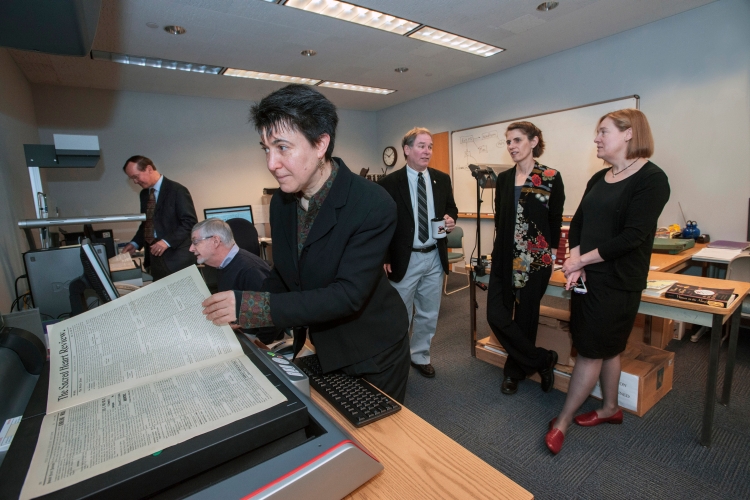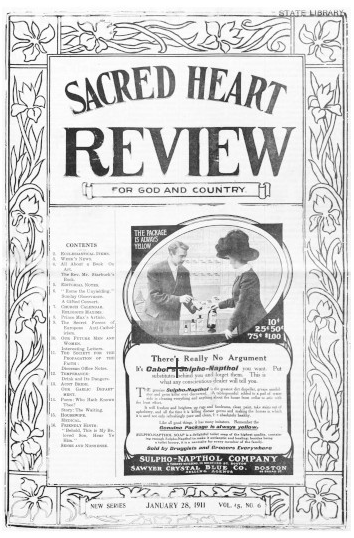
By Melissa Beecher | Chronicle Staff
“We’ll take them.”
It’s not often when a librarian has the opportunity to personally save a piece of history. Yet those three words set in motion a series of events leading to the preservation and digital renewal of an all but forgotten newspaper that chronicled Boston, the Catholic Church and the New England region during the turn of the 20th century.
The digitization of the Sacred Heart Review is the latest project to bolster Boston College Libraries’ expanding digital collection, searchable by researchers and academics throughout the world.
Published from 1888 through 1918, the Sacred Heart Review was edited by Rev. John O’Brien, pastor of the Sacred Heart Church in East Cambridge. Far from a church bulletin, each edition of the paper was 16 pages that reported on religious news, the church community, regional and world events and editorials that pointedly defended Catholicism.
In February 2008, while preparing for the renovation of the School of Theology and Ministry library, Burns Library Rare Books Librarian and Senior Cataloger David Richtmyer was sent to review some of the materials held by the St. John’s Seminary library. Warmly greeted by the librarian, Msgr. Laurence McGrath, Richtmyer was ushered into a section of the library known as “the Cabinet Room.” There, amid the rare 15th and 16th-century treasures, was a collection of dusty, seemingly unremarkable bound periodicals: the Sacred Heart Review.
“It was almost as an afterthought that Fr. McGrath asked me if I would be interested in these periodicals,” said Richtmyer. “I asked what would become of these volumes if I did not accept the offer and was told they’d be thrown away. When faced with that prospect, there is only one responsible reply for a rare book librarian to make: ‘We’ll take them.’”
Richtmyer quickly saw historical significance within the pages, which provided a snapshot of Greater Boston prior to World War I. In addition to the front page articles – like that of Pope Benedict XV’s encyclical Ad Beatissimi Apostolorum, which described his grief at the slaughter that had just begun to envelope Europe in 1915 – the Review’s advertisements illustrate the less notable events, like the rise and fall of gas lighting vis-à-vis the Cambridge Gas Light Company advertisements.
It took years for a small team at University Libraries to do the painstaking inventorying, assessment, cataloging and digitization required before making the collection available to the public. Boston College is the only institution to have the complete holdings of the Review.
Head Librarian of Digital Library Programs Elizabeth Post said this particular collection was digitized without compromising the original primary materials. Bookbindings typically need to be destroyed when digitization projects are undertaken, but Boston College archivists and staff took great care to preserve the primary materials, she said.
In conjunction with the Catholic Research Alliance and the Catholic Newspapers Program, other religious periodicals are being catalogued, preserved and digitized at Boston College due to the high public, historic and academic interest.
“When we undertake a project like this, there are key points that must be considered: if there is value to researchers; a thoughtful way to best present the materials; the quality of the materials; cost,” said Post. “We have been pleased to see that this collection has already been widely used with 1,400 visits per month online. In this case, it became very clear that we were preserving the history of the Church in Boston, and its story of immigrant life, especially Irish immigrant life.”
Catholic periodicals, said Irish Studies Librarian Kathleen Williams, were used as a communication vehicle for Catholic families both in Ireland and America with “Letters to the Editor” showing individuals searching for missing family members.
“You see the disruption that historical moments had on the lives of ordinary people through letters from people desperate for information about family members in the Famine, conflicts or the migration from Europe,” said Williams.
Other rich details are contained in the pages. Richtmyer points to an advertisement – what he calls a “Kickstarter campaign of the day” – in which a man solicits money to help develop a metal, mechanical tire to replace the unreliable rubber tires of the automobile.
“What we, as librarians and archivists, do is quite noble work: the prevention of cultural Alzheimer’s,” said Richtmyer softly. “We do an exercise at the library where we pass around a book from the 15th century to students at a table. At first, they all look like scared fathers who have just been handed a baby. I tell them, ‘this book has held up for 500 years and when we’re all dead and gone, it will still be here strong.’ It’s wonderful to see that moment of recognition in their faces, when they feel the book – touch, smell and turn the pages – that these materials are really monuments to the people who created and owned them.”
The Review online archive has already helped at least one family. Ellen Brewin, a 1976 alumna of Boston College Law School, recently wrote to Richtmyer to express gratitude in finally finding a genealogical link after years of searching with limited results.
“Imagine my surprise to find that my search yielded information from several issues of the Sacred Heart Review which posted letters from young children living in Tawnytaskin in 1911-1912,” she wrote. “It gave me goosebumps to feel the years between us just slide away and feel almost as if it were the present.”
The digitization of the Sacred Heart Review was made possible through the work of Bill Donovan, Betsy McKelvey, Brian Meuse, Naomi Rubin and Margaret Huang, and University Librarian Thomas Wall.




